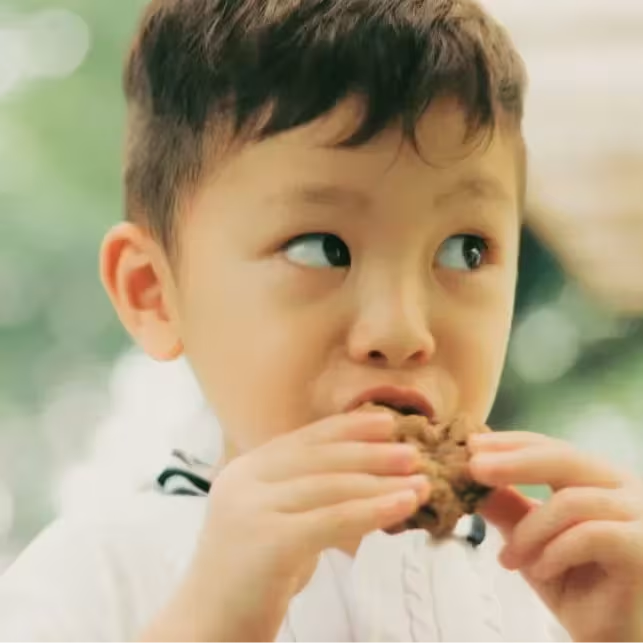Introduction to macronutrients and how the narrative has changed
Updated Jan 02, 2026

There’s so much to think about when it comes to feeding children, so when someone mentions macronutrients, it’s okay if the thought makes your head spin a bit. Are macronutrients one more thing to keep track of? Well - no, not really! Macronutrients are found in all foods and when we aim to serve a variety of foods to our children, things tend to fall in line. Keep reading for all you need to know about macronutrients including tips on how to best incorporate them into your child’s diet.
What are macronutrients?
The three macronutrients, carbohydrates, protein, and fat, are the building blocks of food. They provide our bodies, both children and adults, with energy as well as contribute to many other critical body functions. Most foods contain a mixture of the three macronutrients, but oftentimes foods are categorized by the macronutrient they contain in the largest amount. The main functions are:
Carbohydrates
Carbohydrates, or carbs for short, are our bodies' primary source of energy. They are found in many foods including fruits, vegetables, grains, and dairy foods.
Protein
Protein builds and repairs muscle and other body tissues play an important role in immune function as well as help transport molecules throughout the body. It can be found in animal foods such as meat, dairy, and as well as plant foods like , seeds, whole grains, and soy products.
Fats
Fat serves as a long-term source of energy, plays an important role in brain development as well as provides insulation and cushion for the body’s organs. Two types of fats, saturated and unsaturated, exist and function differently in the body.
How the narrative has changed over time
If you’ve ever felt confused by which macronutrients are best to choose, you are likely, not alone. One day fat is out and carbs are in. The next, carbs are in and fat is out! The potential superiority of one macronutrient over another is highly-debated, even in circles of health experts. However, one thing is clear: aiming to serve your family a healthy balance of all three won’t steer you wrong.
This is especially true for children who need the benefits of all three macronutrients to grow and develop properly. Low-carb diets may deprive them of much-needed energy sources while a low-fat diet may slow critical brain development. So hopefully we’ve learned from the narratives of the past and found that when one macronutrient is praised over another, an important balance is disrupted, and health can suffer.
Carbohydrates
Carbohydrates are the body’s main and preferred source of energy. After eating, they are broken down into simple sugars that circulate in the blood to provide quick energy to muscles and the central nervous system (including the brain!). This ready-to-use source of fuel is critical for kiddos, who as we know like to always be on the go. In school-aged children, eating enough carbohydrates allows them to better focus and learn in class.
Many carbohydrate-containing foods, such as fruits, vegetables, and whole grains, also contain other important nutrients such as vitamins, minerals, and fiber. Fiber is especially important as it helps keep little (and adult!) bellies full, promotes healthy digestion as well as contributes to a thriving gut microbiome.
Ways to include carbohydrates in your child’s diet
There’s no need to worry about serving a certain amount of carbohydrates a day, unless medically necessary, but rather focus on serving a variety of different carbohydrate-containing foods.
Get creative with fruits and veggies
At times, it can feel like a struggle to get kids to enjoy fruits and veggies. Try serving them in fun ways by making smoothies, cutting them into shapes, or serving them with a dip.
Choose whole grains
When possible, choose whole grain products to up your kiddos intake of fiber. Try whole-grain bread or pasta, whole-grain crackers, or even popcorn for a whole-grain snack. Reminder: Popcorn is a choking hazard for kiddos under 4.
Serve dairy or dairy alternatives
Although sometimes thought of as protein foods, dairy products, such as contribute carbohydrates to the diet. Try pairing them with fruit!
Protein
Protein is often thought of as the muscle-building nutrient - and while it does support healthy muscle growth - protein does so much more! It helps support the immune system, produce hormones, strengthen skin, and transport nutrients. Additionally, consuming protein helps to balance blood sugar and keep kids full for longer after a meal or snack.
Protein is found in many foods and there is no need for most parents to worry if their child is eating enough protein. Aim to serve a mixture of plant (beans, nuts, whole grains) and animal (meat, fish, eggs, dairy) proteins to support optimal growth and development.
Ways to include protein in your child’s diet:
Boost with plant proteins
Adding nuts, nut butters, or seeds to foods can boost the protein content. Think chopped nuts on top of yogurt, almond butter mixed into oatmeal, or sprinkle chia seeds over fruit.
Use dairy products
Milk, yogurt, and cheese all contribute protein to your child’s diet. Pair these foods with fiber-filled food like fruit, veggies, or whole grain crackers for a satisfying snack.
Try beans and lentils
Pulses, the food group made up of beans and lentils, are high-protein and fiber-filled. For many kids, these foods are accepted easier than meat which can be hard to chew.
Fats
Fat is essential in children’s diets to support overall growth and development, especially brain development. Fat provides energy, helps regulate body temperature, and allows the absorption of fat-soluble vitamins. It also makes food taste good and helps you feel full after eating.
While it’s true that different types of fats impact health differently, there’s no reason to fear fats. Aim to provide fat from mostly whole foods sources - plant foods (think nuts, seeds, olives, avocados) or animal foods (think lean meat, fish, dairy, or eggs). Omega-3 fatty acids found in fish, walnuts, and chia seeds are important specifically for brain development.
Ways to include fats in your child’s diet:
Choose fortified products
If your child is still learning to like fish, lean into fortified products to get omega-3s. Some milks and eggs have these essential fatty acids added.
Cook with plant oils
Cook vegetables with olive oil or another plant oil to increase unsaturated fat consumption.
Snack on nuts and seeds
As age-appropriate, add nuts and seeds to snacks. Try making your own trail mix or granola at home and incorporating different types of nuts and seeds.
Share article:
Note: The content on this site is for informational purposes only and should not replace medical advice from your doctor, pediatrician, or medical professional. If you have questions or concerns, you should contact a medical professional.
Share article:







